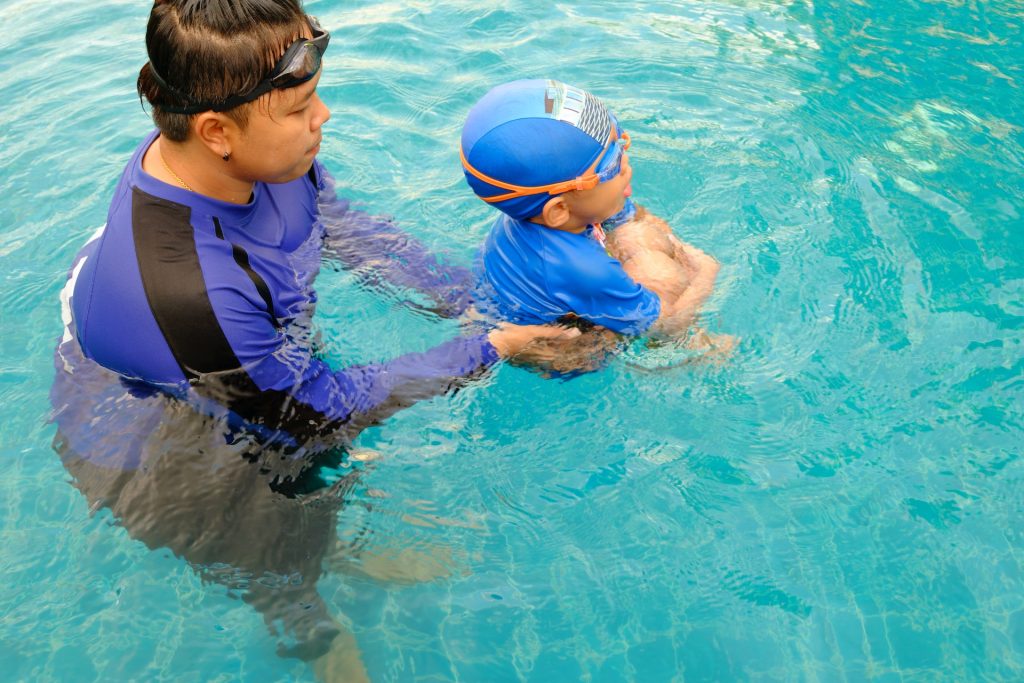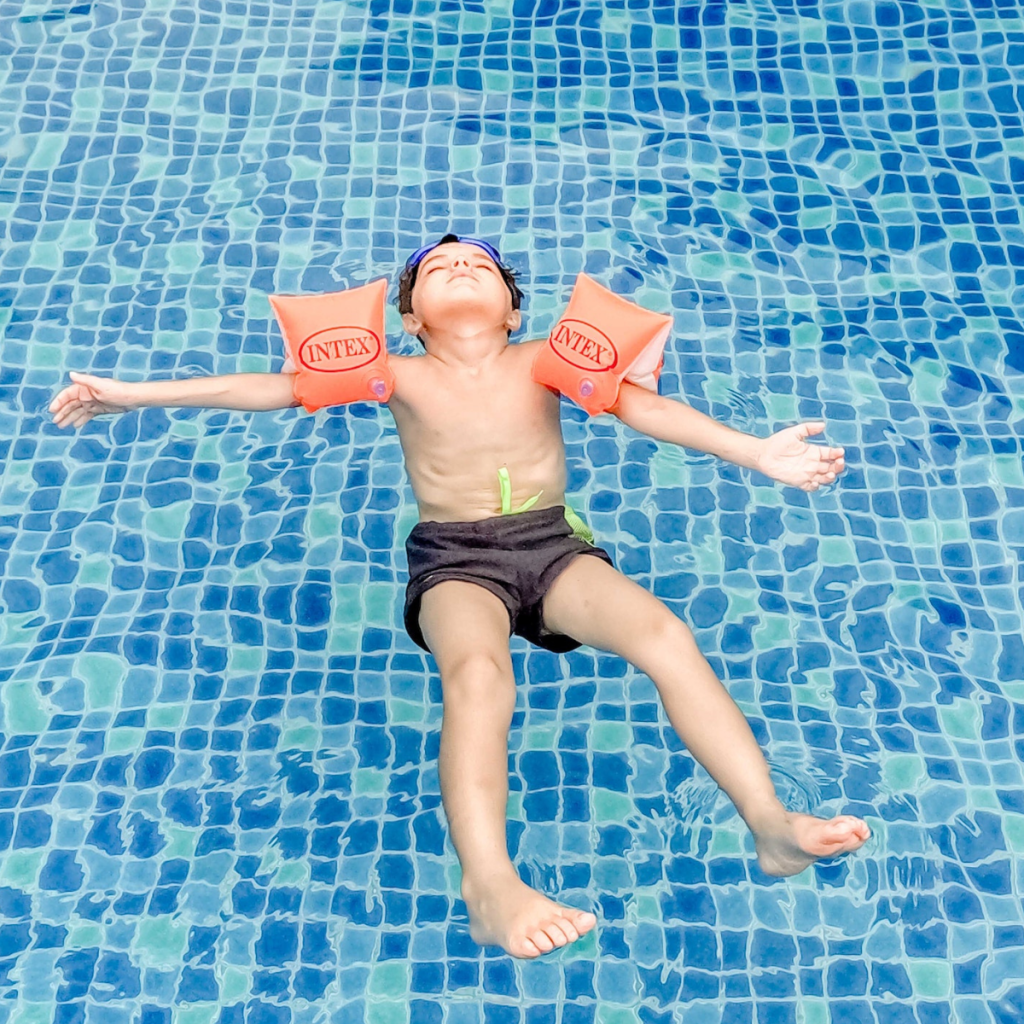Learn effective techniques and strategies for teaching swimming to 3-4 year old children.
How to Teach Swimming to a 3-4 Year Old Child
Teaching swimming to a young child can be a wonderful and rewarding experience. Not only does it help them develop important life skills, but it also introduces them to a fun and healthy activity. In this article, we will explore the basics of child swimming and provide you with helpful tips on how to teach swimming to a 3-4 year old child.
Understanding the Basics of Child Swimming
Before diving into the exciting world of teaching swimming, it is important to recognize the significance of water safety. Children at this age are naturally curious and can easily get themselves into trouble near water. Therefore, educating them about water safety is a crucial aspect of teaching swimming.

Importance of Water Safety
Make sure your child understands that swimming is meant to be enjoyed but always under supervision. Teach them about the importance of never swimming alone and the dangers of rough waters or deep pools. You can also introduce them to basic water rescue techniques, such as floating on their back or holding onto a flotation device.
Furthermore, it is essential to educate children about the potential risks associated with swimming in natural bodies of water, such as rivers, lakes, or the ocean. Teach them about currents, tides, and how to identify safe swimming areas. Additionally, emphasize the importance of wearing appropriate safety gear, such as life jackets, when engaging in water activities.
Age-Appropriate Swimming Skills
At the age of 3-4, children are still developing their physical coordination and motor skills. They may not yet have the strength or coordination to perform complex swimming strokes. However, they can start learning basic swimming skills, such as kicking their legs and moving their arms in the water. Encourage them to explore the water and gradually build their confidence.
Introducing children to different water environments can also help them develop their swimming skills. Take them to a variety of swimming pools, including those with shallow and deep areas, to expose them to different water depths. This exposure will help them become comfortable with various swimming conditions and build their water confidence.
Overcoming Fear of Water
Some children may have a fear of water, which can make teaching swimming more challenging. The key is to introduce water activities gradually and in a playful manner. Start with simple water play at home, using toys and games to help them become comfortable with the water. Encourage them to splash, pour water, and play with floating toys.
Additionally, consider enrolling your child in water playgroups or swim lessons with other children of similar age. Being around peers who are also learning to swim can help alleviate fears and create a supportive environment. The presence of a qualified swimming instructor can further boost their confidence and provide guidance on overcoming their fear of water.
It is important to remember that every child is unique, and their progress in learning to swim may vary. Patience, encouragement, and a positive attitude are key when teaching children to swim. With time and practice, they will develop essential swimming skills and gain confidence in the water.
Preparing Your Child for Swimming Lessons
Before enrolling your child in swimming lessons, it is important to prepare them both physically and mentally. Here are some tips to help you get ready:
Choosing the Right Swimwear
Invest in swimwear that fits your child comfortably and allows for unrestricted movement. Look for swimsuits with built-in floatation devices for added safety, especially when they are starting out.
When choosing swimwear for your child, consider their preferences and comfort. Let them pick out a swimsuit that they like, as this will make them more excited about the upcoming swimming lessons. Additionally, ensure that the swimwear is made of high-quality materials that are durable and chlorine-resistant, so it can withstand regular use.
It is also important to consider the weather and temperature of the swimming facility. If the lessons are taking place in an outdoor pool, make sure to choose swimwear that provides adequate sun protection, such as a rash guard or a swimsuit with UV protection.
Introducing Water Play at Home
Prior to the lessons, introduce your child to water play at home. Fill up a small pool or use a bathtub and let them immerse themselves in a safe and controlled environment. This will help them become familiar with the sensation of being in the water.
During water play at home, you can engage your child in various activities to build their water confidence. Use toys, such as floating ducks or cups, to encourage them to splash and play in the water. This will help them develop a positive association with water and make them more comfortable when they start their swimming lessons.
Furthermore, you can teach your child basic water safety skills at home, such as blowing bubbles in the water or practicing floating on their back. These skills will give them a head start and boost their confidence when they enter the swimming lessons.
Discussing What to Expect
Having an open conversation with your child about what they can expect during swimming lessons can help set their expectations and alleviate any anxieties they may have. Explain that swimming is fun and that they will learn new skills while making new friends.
Take the time to discuss the structure of the swimming lessons with your child. Let them know that there will be a qualified instructor who will guide them through various activities and exercises. Assure them that they will be in a safe and supportive environment, surrounded by other children who are also learning to swim.
Emphasize the importance of listening to the instructor and following their instructions. Explain that the instructor is there to help them learn and improve their swimming abilities. Encourage your child to ask questions and seek help when needed, as this will foster a positive learning experience.
Additionally, highlight the benefits of swimming, such as improved physical fitness, increased water safety awareness, and the opportunity to participate in water-based activities with family and friends. By discussing these positive aspects, you can help your child feel excited and motivated to start their swimming lessons.
Techniques for Teaching Swimming to Young Children
Now that your child is prepared, it’s time to dive into the actual teaching process. Here are some techniques that can be effective in teaching swimming to young children:
Using Toys and Games to Teach Swimming
Make learning fun by incorporating toys and games into your swimming lessons. For example, you can create a game where your child has to retrieve toys from the bottom of the pool or encourage them to kick their legs as they chase after floating objects. This will keep them engaged and excited about swimming.
One popular game is “Marco Polo,” where one person closes their eyes and tries to find the others in the pool by calling out “Marco” and listening for the response of “Polo.” This game not only teaches children to navigate the water using their senses but also helps them develop their swimming skills as they move around the pool.
Additionally, you can use colorful pool toys, such as diving rings or floating animals, to create a treasure hunt. Hide the toys in different areas of the pool and encourage your child to swim and find them. This activity will not only improve their swimming abilities but also enhance their problem-solving skills and spatial awareness.
Teaching Basic Swimming Strokes
While your child may not yet have the strength or coordination to perform full swimming strokes, you can still introduce them to the basics. Demonstrate how to kick their legs and move their arms in a coordinated manner, and encourage them to mimic your movements. Remember to be patient and provide plenty of positive reinforcement.
One effective technique for teaching basic swimming strokes is to use flotation devices, such as arm floaties or kickboards. These aids provide support and help children focus on mastering the movements without the fear of sinking. Start by having your child hold onto a kickboard while kicking their legs, gradually progressing to using their arms as well.
Another technique is to have your child practice swimming with a noodle. Hold one end of the noodle while your child holds the other end, and encourage them to kick their legs and move their arms as if they were swimming. This exercise helps them develop the muscle memory and coordination needed for swimming strokes.
Building Confidence in the Water
Building confidence is an essential part of teaching swimming. Gradually increase the difficulty of the tasks and provide continuous support and encouragement. Celebrate even the smallest achievements, as this will help your child develop a positive attitude towards swimming.
One way to build confidence is to introduce your child to different water depths. Start with shallow water where they can touch the bottom and gradually move to deeper areas as they become more comfortable. This progressive approach allows them to gain confidence in their ability to float and swim in various water depths.
Additionally, practicing water safety skills can boost your child’s confidence. Teach them how to properly enter and exit the pool, how to float on their back, and how to tread water. Knowing these essential skills will give them a sense of security and empower them to explore and enjoy the water.
Remember, every child learns at their own pace, so be patient and supportive throughout the teaching process. With these techniques and your encouragement, your child will soon become a confident and skilled swimmer.
Monitoring Progress and Ensuring Safety
As your child progresses in their swimming journey, it is important to keep a close eye on their development and ensure their safety at all times.

Recognizing Signs of Progress
Be observant and look for signs of progress in your child’s swimming abilities. It can be as simple as them floating on their own or using correct kicking and arm movements. Celebrate these achievements and let your child know how proud you are of their efforts.
Understanding Potential Risks and How to Avoid Them
While swimming is a fun activity, it is important to be aware of the potential risks involved. Always supervise your child when near water, whether it’s during swimming lessons or recreational swimming. Ensure that the pool or swimming area is safe and age-appropriate for your child.
When to Seek Professional Help
If you feel that your child is not progressing as expected or has a fear of water that persists despite your efforts, it may be beneficial to seek professional help. A qualified swimming instructor can provide specialized guidance and help address any issues that may be hindering your child’s progress.
Teaching swimming to a 3-4 year old child requires patience, creativity, and a playful approach. By understanding the basics of child swimming, preparing your child for lessons, using effective teaching techniques, monitoring progress, and ensuring safety, you can help your child develop valuable swimming skills and a lifelong love for the water.



